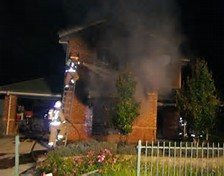.png)
By: Robert Avsec
The science is becoming increasingly clear: Any exposure to smoke by a firefighter is an exposure to hazardous materials. Every day. Every time. And not just as an inhalation hazard, but from a skin contact and absorption perspective as well from exposure to carbon particulates and off-gassing volatile organic compounds (VOCs) from their personal protective gear, aka, turnout gear.
Firefighters who are exposed to smoke are at risk for acute threats like poisoning from carbon monoxide and hydrogen cyanide, aka, “the toxic twins,” that are present in all smoke resulting from combustion. In addition, there are literally thousands of other chemicals and compounds in smoke, some of which, like benzene, have been identified as carcinogens. Which brings us to the long-term consequences of firefighter exposure to smoke and other products of combustion: Firefighters develop cancer at rates greater than the general population.
The National Institute for Occupational Safety and Health (NIOSH) studied 30,000 firefighters from the Chicago, Philadelphia, and San Francisco fire departments with the goal of better understanding the link between firefighting and cancer. Researchers at the National Cancer Institute and the University of California at Davis Department of Public Health Sciences, participated in the study which was funded in part by the U.S Fire Administration.
Those researchers studied mortality patterns and instances of cancer within this group of career firefighters, and found:
• Compared to the general population, the study population had higher rates of cancer, primarily from cancers of the respiratory, digestive, and urinary systems.
• The study population had a rate of mesothelioma two times greater than the rate in the U.S. population.
• Smoke and other products of combustion expose firefighters to contaminants that are known or suspected to cause cancer, including by-products such as benzene and formaldehyde, and materials in debris from older structures, e.g., asbestos.

• Respiratory irritants (acrolein, acids, sulfur dioxide);
• Respiratory sensitizers (isocyanates, aldehydes)
• Chemical asphyxiates (CO and HCN)
• Cardiotoxicants (fine particulate, chemical asphyxiates)
• Carcinogens: Single-ring aromatic hydrocarbons (benzene); polycyclic aromatic hydrocarbons; and (benzo[a]pyrene); aldehydes (formaldehyde); halogenated compounds (vinyl chloride, polychlorinated biphenyl, dioxins).
Fire Suppression Meets Hazmat Incident Management If a fire department is serious about protecting their people from the hazards of fire suppression—particularly interior structural fire suppression—then it’s incumbent on its leadership to “overhaul” its approach to fire scene management. This is not heading towards a discussion on fire suppression strategies and tactics per se (though some elements will be touched upon). Rather, I’m advocating for a vastly different approach to our personnel management and site control when responding to all fires, not just structure fires.
Control Zones
The incident commander (IC) must establish and enforce control zones for every emergency incident: Hot Zone: The hazard area where the use of personal protective clothing and SCBA is required. Warm Zone: The reduced hazard area where personnel are not exposed to radiant heat or smoke or other products of combustion. Should be located upwind and uphill from the Hot Zone whenever possible. The Decontamination Unit should be set up as the interface for personnel to exit the Hot Zone into the Warm Zone. Cold Zone: The hazard-free area where no personal protective clothing or gear is needed. The on-scene firefighter rehab area should be located in the Cold Zone.
Personnel Management
The three key elements in protecting personnel in a hazardous materials situation have always been:
• Time. Limit the time spent in the hazard area to the absolute shortest duration necessary to complete the job.
• Distance. When the job or task is completed, put as much distance as possible between yourself and the hazard area.
• Shielding. Always wear the appropriate level of personal protective clothing for the hazard, including SCBA when a respiratory hazard is present.
In the fire service, we have to greatly improve our use of these key concepts on all fire situations where our personnel could be exposed to smoke and other products of combustion. The IC, and tactical leaders operating in the Hot Zone, e.g., Division or Group Supervisors or Crew Leaders, must ensure that only the number of personnel necessary for operations are in the Hot Zone. They must also ensure that all personnel in the Hot Zone are wearing PPE and breathing cylinder air from their SCBA.
When their assigned task(s) are completed, and no other task(s) are forthcoming, personnel should exit the Hot Zone and relocate to the Warm Zone. If the IC deems that there will be no further need for those personnel, they should proceed to the Decontamination Unit for Stage I decontamination (gross wash) as a minimum.
After doffing their PPE and SCBA at the interface between the Warm Zone and Cold Zone, firefighters then go to the on-scene firefighter rehab area for medical monitoring as outlined in NFPA 1584, Standard on the Rehabilitation Process for Members During Emergency Operations and Training Exercises. When released from Rehab, if personnel are going to be needed for operations in the Hot Zone they should reclaim their PPE and SCBA from the Warm Zone (where they doffed it).
If those personnel are released from the scene by the IC for return to the their respective stations, they should bag their PPE and SCBA (using heavy-duty plastic bags) and put it aboard their apparatus (not in the crew compartment) for the return to the station.
Summary
Increasingly, we are learning that firefighters and officers are exposed to very serious chemicals and compounds resulting from the combustion process. It is incumbent upon us as fire service leaders to recognize that every fire suppression situation is a hazardous materials event and must be managed as such.
That means that fire officers and firefighters must become knowledgeable and skilled in the basics of hazardous materials site safety practices as outlined in NFPA 472: Standard for Competence of Responders to Hazardous Materials/Weapons of Mass Destruction Incidents:
• Time, Distance, and Shielding;
• Operational Control Zones: Hot, Warm, and Cold; and
• Personnel workflows through the Operational Control Zones.
Keep in mind that these are only the basics. Personnel who have completed Hazardous Materials Training—Awareness Level and Operations Level—should be familiar with these terms and operational concepts. Fire service leaders must build up those base competencies so that they become a part of every fire suppression operation.

Battalion Chief (Ret) Robert P. Avsec served with the men and women of the Chesterfield (VA) Fire & EMS Department for 26 years. His career as a fire officer is rather unique in that he spent a cumulative total of 9+ years in staff officer positions as: Director of EMS Division, Co-Manager of Emergency Communications Center (911), and Director of Training & Safety Division. Chief Avsec also served multiple tours of duty in the department's Emergency Operations Division.
Chief Avsec holds a Bachelor of Science degree in Fire and Safety Engineering Technology from the University of Cincinnati and a Master's degree in Executive Fire Service Leadership from Grand Canyon University in Phoenix, AZ. He also is a graduate of the National Fire Academy's Executive Fire Officer Program. His post-retirement career has included consulting work with a private sector EMS agency, staff instructor and course developer with the Georgia Fire Academy, and private sector consulting with Department of Defense and federal agencies. Today he is a freelance writer for a major fire service trade journal on-line and has his own blog, ‘Talking “Shop” 4 Fire and EMS.’








